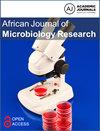Beneficial microorganisms as affecting root development of upland rice
引用次数: 0
Abstract
Multifunctional microorganisms can significantly affect root and shoot development of upland rice seedling that could provide an increase in the crop grain yield. The objective of this study was to determine the effect of single and combined microorganism on the root and shoot development of upland rice seedlings. The experiment was arranged in a completely randomized design with treatments consisting of the upland rice seeds treated with single and combined multifunctional microorganisms (M01 ( Serratia marcescens ) , M02 ( Bacillus toyonensis ), M03 ( Phanerochaete australis) , M04 ( Trichoderma koningiopsis ), M05 ( Azospirillum brasilense ), M06 ( Azospirillum species), M07 ( Bacillus species), M08 to M28 (combination of these microorganisms) and M29 (control – no microorganism). S. marcescens with B. toyonensis led to the greatest increase (296%) in root length relative to the control. B. toyonensis with A. brasilense greatly increased root surface area by 209% in comparison to the control. An increased root diameter by 36% was recorded for upland rice inoculated with A. brasilense with Bacillus spp. in relation to the control. P. australis with Bacillus spp. greatly increased root volume (47%) in comparison to the control. It can be concluded that multifunctional microorganisms enhanced root length, root surface area, root diameter and volume, and provided better root development影响陆稻根系发育的有益微生物
多功能微生物可显著影响陆稻幼苗的根冠发育,从而提高作物产量。本研究的目的是确定单一和组合微生物对陆稻幼苗根冠发育的影响。实验以完全随机的设计进行,处理包括用单一和组合的多功能微生物处理的陆稻种子(M01(粘质沙雷氏菌)、M02(toyonensis芽孢杆菌)、M03(澳大利亚原毛平革菌)、MO 4(康氏木霉)、M05(巴西固氮螺菌)、,M08至M28(这些微生物的组合)和M29(对照-无微生物)。粘质S.marcescens和B.toyonensis导致根长相对于对照增加最大(296%)。与对照相比,B.toyonensis和A.brasilense显著增加了209%的根表面积。与对照相比,接种了枯草芽孢杆菌的陆稻的根径增加了36%。与对照相比,具有芽孢杆菌的P.australis的根体积显著增加(47%)。结果表明,多功能微生物提高了根系的长度、根表面积、根径和体积,促进了根系的发育
本文章由计算机程序翻译,如有差异,请以英文原文为准。
求助全文
约1分钟内获得全文
求助全文

 求助内容:
求助内容: 应助结果提醒方式:
应助结果提醒方式:


